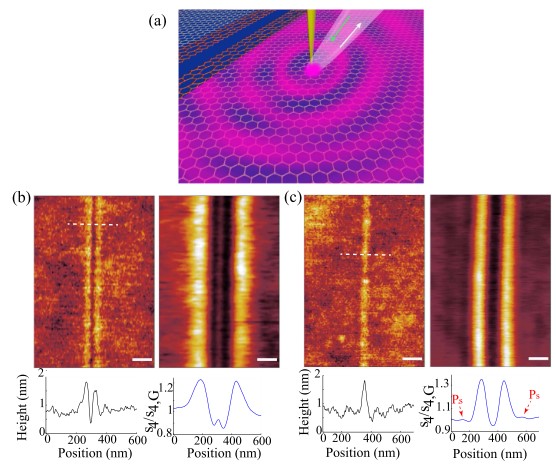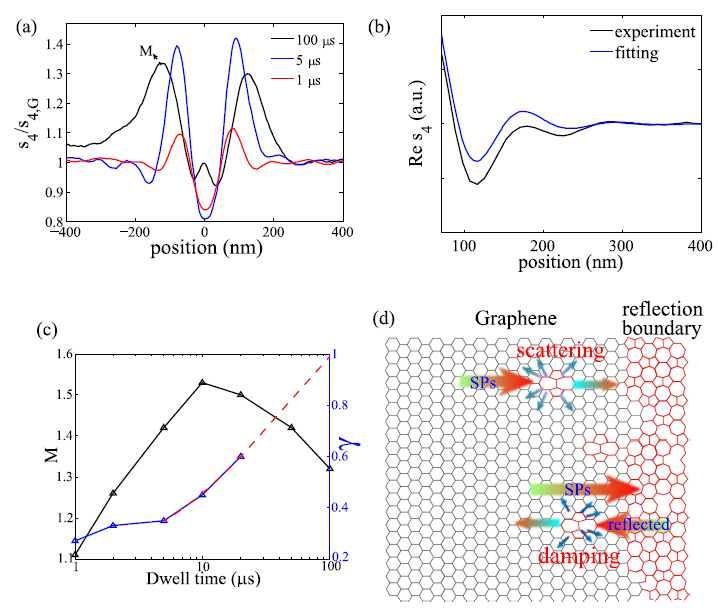An important member of graphene defect engineering - surface plasmon reflex
Graphene is a two-dimensional material that has received extensive attention in recent years. It has unique physical and chemical properties and has broad application prospects in signal sensing, substance detection, and energy battery fields. In September 2016, the research team of Xu Jingjun and Cai Wei from Nankai University published a full-text article entitled “Tailorable re-ection of surface plasmons in defect engineered graphene†in the international journal 2D Materials, and changed graphene light and electricity by exploring defects. The possibility of thermal properties, proposed the idea of ​​manipulating the plasmon properties of graphene nanoscale, and opened up a new chapter for the realization of nanoscale optoelectronic devices in the future.

(a) Schematic diagram of NeaSNOM measurement principle (b) AFM imaging of NeaSNOM shows the morphology of the graphene defect (c) Nano-microscopic optical imaging of NeaSNOM shows the surface plasmon wave propagation pattern of the region
The research team of Xu Jingjun and Cai Wei first designed the feasibility of ion beam to control the defect boundary of graphene, and repeated verification of this idea by conventional measurement methods such as AFM to test its feasibility. The research team conducted in-depth research on the propagation of plasma waves on the surface of graphene at the defect boundary. Through the reliable plasmon imaging method provided by NeaSNOM, the obvious interference fringes near the boundary were observed in their near-field plasmon imaging images. With a typical graphene wedge structure, the effective scattering waves of the plasmons at the boundary are greatly enhanced by the manipulation defects. The plasmon reflection at the boundary of the defect was first clearly observed, confirming the role of these defects in the scattering center of the surface plasmon wave propagation.

Study on the Propagation and Reflection of Moderate Ion Excitons of Graphene with Different Degrees of Defects
At the incident laser wavelength of 10.653 um, different degrees of defect graphene medium ion excitation and reflection studies. Among them, the first interference peak of plasmon is defined as M, and the attenuation ratio at the boundary is 0.28. The experimental results are well fitted with the theoretical values.
The research team demonstrated the conclusion that by changing the reflection of plasmons at the graphene defect boundary by introducing an ion beam, they believe that the defect can serve as an effective plasmon propagation scattering center, and the plasmon can be realized by controlling the defect degree. Control, this research effectively opened up a new chapter in the control of surface plasma waves.
References: Luo W, Cai W, Wu W, et al. Tailorable reflection of surface plasmons in defect engineered graphene [J]. 2D Materials, 2016, 3(4): 045001.
The research process and experimental results involved in this paper are subject to the original work.
About Quantum Design
Quantum Design is the world's leading manufacturer and distributor of scientific equipment, and was founded in 1982 in San Diego, California. The company's SQUID Magnetic Measurement System (MPMS) and Material Integrated Physical Property Measurement System (PPMS) have become the world's recognized top-level measurement platform, widely distributed in the world's most research-oriented fields of materials, physics, chemistry, nanotechnology, etc. laboratory. In 2007, Quantum Design acquired LOT, the largest instrument distributor in Europe, and has become a world-renowned multinational company in the field of scientific instruments. At present, the company has dozens of branches and offices in the United Kingdom, the United States, France, Germany, Brazil, India, Japan and China, and operates in more than 100 countries and regions around the world. China is the most active market for Quantum Design, with offices or offices in Beijing, Shanghai and Guangzhou. Over the past decades, the company's cooperation with China's research and education fields has been fruitful, providing advanced equipment and high-quality services for the advancement of Chinese scientific research.
Sidelight Curtains,Patio Door Curtains,Curtains For Closet Doors,Sorghum Leaf Door Curtains
Shandong Guyi Crafts Co.,Ltd , https://www.sddoorcurtains.com